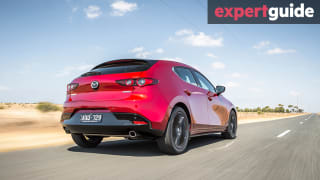
Mazda 3 2019 review
Move over Hyundai i30, Toyota Corolla and Kia Cerato, the new Mazda3 has arrived.
Browse over 9,000 car reviews

Hyundai’s entry-level Veloster sits at $31,790, the automatic entry-point in a limited, three-variant range.
Sitting below the Veloster Turbo (from $35,490) and Turbo Premium (from $38,990), the entry-level Veloster is powered by a 2.0-litre, non-turbo four-cylinder engine.


That engine has the same outputs as the Veloster’s i30 stablemate (110kW/180Nm) and can be mated either to a six-speed manual ($29,490) or a six-speed auto, as tested here. All Velosters are front-wheel drive only.
While the engine might not be as sporty as the Veloster’s looks, the base model does come with an impressive list of standard features. These include sporty 18-inch alloy wheels (wearing Michelin Pilot Sport 4 tyres), a 7.0-inch multimedia touchscreen featuring Apple CarPlay and Android Auto, a 3.5-inch TFT screen in the dash, a six-speaker stereo, heated and power adjustable wing mirrors, single-zone climate control, LED DRLs and auto halogen headlights.

This base car does have some entry-level items, like turn-key ignition and manually adjustable cloth seats.
The Veloster’s unique drawcard is its shape and its single door for the two rear seats. The Veloster has a much smaller boot than its i30 sibling, at 303 litres. The space can be increased to 1081L with the rear seats down.

All the typically practical Hyundai fittings for front occupants are present and accounted for, including large trenches and big cupholders in the centre console and doors, suitable for at least 500ml containers. There are no air vents for rear passengers, but they do get two large cupholders and a storage trench instead of a middle seat.

On the active-safety front, the entry-level Veloster gets city-speed auto emergency braking (AEB), driver-attention alert, lane-keep assist, and torque vectoring. It does not have a radar, like the Turbo, and hence misses out on freeway-speed auto emergency braking and active cruise control.
Standard safety features include six airbags and the expected electronic stability and brake controls. Every Veloster gets a reversing camera and two ISOFIX and top-tether child-seat mounting points on the rear two seats. This generation Veloster has not yet been rated by ANCAP.

The automatic 2.0L Veloster runs on base-grade 91RON unleaded petrol and has a claimed/combined fuel-usage figure of 7.1L/100km. We scored 9.4L/100km against that claimed figure on our week-long test. It has a 50-litre fuel tank.
All passenger Hyundai vehicles currently carry a five-year, unlimited-kilometre warranty, and have a comprehensive capped-price-servicing regime that carries well beyond the warranty period. The average cost over the first five years is $332.20 per year.

| Vehicle | Specs | Price* | |
|---|---|---|---|
| (base) | 2.0L, ULP, 6 SP AUTO | $21,670 – 27,390 | 2020 Hyundai Veloster 2020 (base) Pricing and Specs |
| Turbo | 1.6L, ULP, 6 SP MAN | $25,740 – 31,790 | 2020 Hyundai Veloster 2020 Turbo Pricing and Specs |
| Turbo Premium | 1.6L, ULP, 6 SP MAN | $29,040 – 34,980 | 2020 Hyundai Veloster 2020 Turbo Premium Pricing and Specs |
| Turbo Premium TTR | 1.6L, ULP, 7 SP AUTO | $32,340 – 38,500 | 2020 Hyundai Veloster 2020 Turbo Premium TTR Pricing and Specs |
$20,020
Lowest price, based on third party pricing data